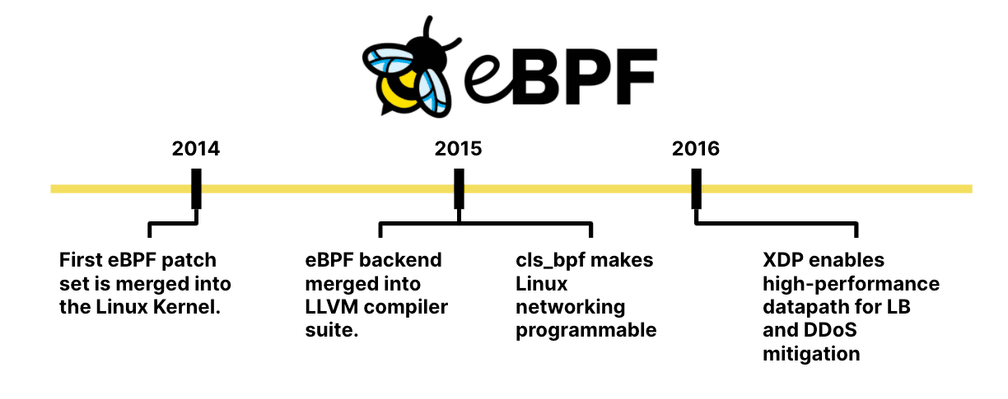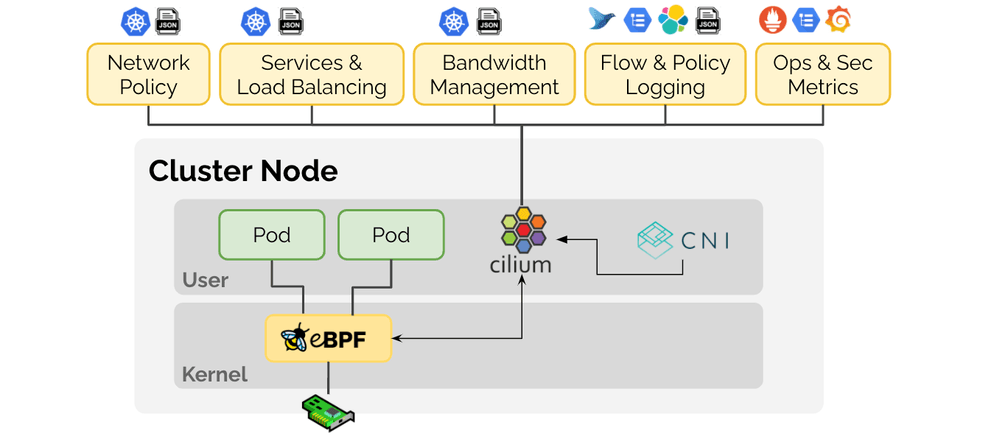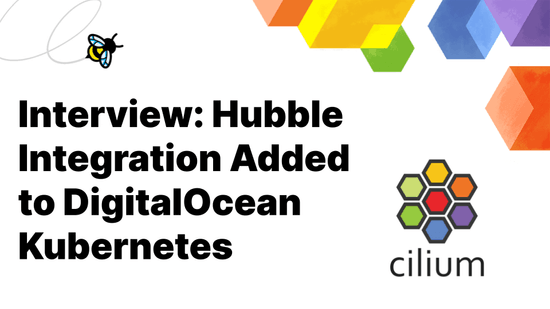eBPF - The Future of Networking & Security

Today is an exciting day for the Cilium community: Isovalent, the company behind Cilium, is announcing its $29M Series A financing round backed by Andreessen Horowitz, Google, and Cisco. This is a perfect occasion to take a deeper look into where eBPF-based networking is coming from and to understand what the excitement is all about.
Two weeks ago, we hosted the first ever eBPF Summit 2020. Besides exciting keynotes, several users of Cilium spoke about their use cases including Adobe, Capital One, Datadog, GitLab, Google, and Wildlife Studios. Earlier last month, Alibaba Cloud covered how they are using Cilium for eBPF-based high-performance cloud-native networking. This was just a couple of weeks after Google had announced the availability of a Cilium-based networking dataplane for GKE and Anthos.
The last few months have already been incredibly exciting for the entire team. It's not every day that one of the co-founders of Kubernetes praises the technology and work your team has created.

Today's launch out of stealth is another great moment for the team and an achievement of all team members who have worked incredibly hard for this day. We are looking forward to talk more publicly about what we do as a company while we continue to innovate around our open-source projects.
This moment is a great opportunity to provide a deeper dive into the motivation to use eBPF for networking. What are all these users seeing in Cilium? What is so special about eBPF?
The Roots of Programmability: Software Defined Networking
To really understand the shift, let's briefly look back at the history of networking. In the 90s, networking was almost entirely physical. Cables, perimeters, dial-up modems and a lot of Layer 2. Around the same time, in 1999, iptables was created for Linux and just shortly after, PF was released for BSD. Both projects focused on software-based firewalling. Early signs of a much larger movement later on: software-defined networking. This was the time I personally got involved in Linux networking.
In the years 2003-2008, VLANs were first described, the first release of the Xen hypervisor happened, EMC acquired VMware, and KVM was merged into the Linux kernel. This was the start of the virtualization era but from a networking perspective, not much had changed. Networking of virtual machines was delegated to the underlying physical network by bridging VMs directly to the network. Almost no networking logic existed in software. During this early virtualization era, most of the Linux kernel networking focus was on the TCP/IP stack and optimizing the kernel as a system to run applications.

It was the year 2009 when things got exciting from a software networking perspective. The first version of Open vSwitch was released which brought us software-defined networking (SDN). It brought massive network programmability to the Linux kernel.
This programmability aspect can still be found in eBPF-based networking today and is one of the corner stones. eBPF-based networking has its roots in SDN and evolves it by removing the device-centric model from the equation.
The Rise of Containers and Kubernetes
The year 2013 brought Docker. Docker primarily inherited the networking from the virtualization layers and containers were treated like miniature VMs from a networking perspective. The fundamental shift that Docker brought focused on application packaging with container images and not on the infrastructure side. Therefore, almost all of the early networking solutions for containers were inherited from OpenStack days.

In 2014, the first commit to Kubernetes happened. Kubernetes was obviously not the first project to attempt translating high-level user intent into infrastructure automation, but Kubernetes made a deliberate decision to make a lot fewer assumptions in networking and security. For example, there is no concept of a network or subnet in Kubernetes. This led to an impressive cycle of innovations.
But the quick evolution of Kubernetes also has a dark side: The desire to get to a complete enough state as quickly as possible made it rely on iptables. A packet filter in the Linux kernel I personally worked on while still using a dial-up modem. Clearly not perfectly suited for the task, but widely available and good enough to get started.
The eBPF Revolution Begins
The same year that Kubernetes started, eBPF was first merged into the Linux kernel as a successor to the long-standing packet filter BPF. Hence the name extended BPF or short: eBPF. One year later, the eBPF backend was merged into the LLVM compiler suite, allowing for LLVM to emit eBPF bytecode. In parallel, integration into the kernel's traffic control layer made Linux networking programmable with eBPF.

2016, XDP was merged into the Linux kernel enabling a high-performance datapath by allowing eBPF programs to run directly in the driver of a network device. This is what later unlocked the development of eBPF-based high-performance load balancers driving some of the largest data centers today.
Ever since, eBPF is in an incredibly steep trajectory to evolve further and becomes more and more powerful every year. The general-purpose nature of eBPF allowed for a diverse community to form around it, spanning networking, tracing, security, profiling, and observability.
Cilium & eBPF - An ideal match for the Cloud-Native World
To recap history, with hardware networking, the functionality and scale were mostly defined by the hardware. With software-defined networking a lot of it moved from hardware to software by taking functionality previously provided with hardware, rewrite it in software, and then put the word virtual in front. All of this made sense as long as machines are involved.
Containers and the cloud-native era are not about machines. We care about applications, APIs, and services. Some machines will still exist for a long time but you don't want to build your architecture around them.
However, in modern systems we rarely think about connecting machines, or virtual machines, or even containers really. Instead we’re concerned with connecting microservices. So rather than machines and wires, we think in terms of cloud services, APIs and the higher level protocols and the systems used to connect them. The past was IP addresses, ports, vNICs and VLANS. Now it is service identity, gRPC, Kafka, distributed data stores, remote APIs, etc.
-- Martin Casado, Creator of SDN, Partner, a16z
What makes eBPF and thus Cilium such a great fit to address the new cloud native challenges?
Programmability
The programmability of eBPF makes it possible to adjust to the quickly evolving cloud-native requirements and tackle the increase in scale with ease. Here is an example on how the programmability of eBPF lead Google to adopt Cilium as its new networking dataplane for GKE:
As more and more enterprises adopt Kubernetes, the gamut of use cases is widening with new requirements around multi-cloud, security, visibility and scalability. In addition, new technologies such as service mesh and serverless demand more customization from the underlying Kubernetes layer. These new requirements all have something in common: they need a more programmable dataplane that can perform Kubernetes-aware packet manipulations without sacrificing performance.
Enter Extended Berkeley Packet Filter (eBPF), a new Linux networking paradigm that exposes programmable hooks to the network stack inside the Linux kernel.
-- Gobind Johar, Product Manager, Google Kubernetes Engine
Even more important, eBPF is not networking specific or tied to a particular domain. The generic nature of eBPF not only attracts a much bigger community to innovate, it also avoids making premature assumptions about what building blocks are required to solve future problems. This is a massive advantage over any networking specific programmability solution such as iptables, Open vSwitch, or nftables.

Embedded in the Linux kernel
Some of you may correctly state that programmability already existed in the form of user-space networking. The unique new aspect of eBPF's programmability is being embedded in the Linux kernel. Applications use system calls to interact via the network and the Linux kernel is responsible to handle these system calls. In order for a user-space networking framework to remain transparent to the application, it still has to traverse the socket layer of the Linux kernel. eBPF avoids this by remaining in the kernel altogether.

The reason why this was not more important before is because with virtual machines, the hypervisor created a natural boundary between the network device of the metal machine and the sockets of the operator system inside the VM. With containers, this all happens in the same kernel.
Safety and Efficiency
Why not just load a Linux kernel module then? It obviously provides arbitrary programmability at a very high efficiency. We could dive into the cost of maintaining kernel modules across kernel versions, but the major downside is more trivial: Safety while remaining efficient.
Buggy kernel code will crash your machine. The kernel is not protected from a buggy kernel module. I think people assumed that this is just how things are; that's the price to do kernel programming. eBPF changed this dogma. It brought safety to kernel programming.
-- Alexei Starovoitov, eBPF Co-Maintainer, Facebook
By requiring eBPF programs to pass through a verification process, eBPF programs are significantly more secure than loading a kernel module.
The efficiency is guaranteed by a Just in Time (JIT) compiler that ensures native execution speed of eBPF bytecode.
All of this makes eBPF incredibly powerful, but it is also a low-level technology intended to be used primarily by Linux kernel developers. This is where Cilium comes into play.
Cilium - eBPF-based Networking, Observability, and Security
Cilium is an open source project that has been designed on top of eBPF to address the networking, security, and visibility requirements of container workloads. It provides a high-level abstraction on top of eBPF. Cilium is to eBPF what Kubernetes and container runtimes are to Linux kernel namespaces, cgroups, and seccomp. The right abstraction layer on top.

Let's dive into particular use cases that Cilium is solving:
Networking
-
Network connectivity: In its most basic form, Cilium is a CNI to provide network connectivity to Kubernetes workloads. The eBPF-based datapath features both IPv4 and IPv6 with the ability to support direct-routing, encapsulation/overlay topologies, as well as integration with cloud provider specific networking layers.
-
Service Load-Balancing: Cilium can act as 100% kube-proxy replacement to provide all service load-balancing in a Kubernetes cluster. The implementation is highly scalable and supports direct server return (DSR) with session affinity. If possible, Cilium will perform the load balancing on the system call level and translate the address directly in the
connect()system call instead of relying on network address translation throughout the entire duration of a network connection. -
Edge Load-Balancing: The XDP-based edge load-balancing capability can steer traffic into Kubernetes clusters or run entirely independent of Kubernetes. It supports consistent hashing with Maglev and provides an implementation for Kubernetes service types NodePort, LoadBalancer and services with externalIPs.
-
Multi-cluster connectivity + security: With the multi-cluster ability, Kubernetes clusters can be connected without the introduction of additional gateways or proxies. The notion of global services allows to route service traffic across clusters.
-
Integration of VM/metal: Virtual and metal machines can be seamlessly connected with Kubernetes workloads without proxies or gateways by representing such external workloads in the Kubernetes cluster as if the workload would run as a pod.
Security
-
Network Policy: Full support for Kubernetes Network Policy based on a modern identity-based implementation built entirely in eBPF. Extensive visibility functionality eases problem troubleshooting and compliance monitoring.
-
FQDN/DNS-based: Transparent integration with DNS-based service discovery allows for network policies based on DNS names instead of IP address blocks to cope with the highly dynamic nature of modern services backed by constantly changing set of IP addresses. The built-in DNS authorization further improves the security model.
-
API Awareness: Transparent injection of Envoy and other proxies on an on-demand basis enables policy enforcement on API level, e.g. HTTP, Kafka, gRPC, Cassandra, ...
-
Policy-driven SSL termination & injection: SSL termination and injection of SSL certificates is policy driven, allowing to terminate SSL connections on behalf of an application or to transparently inject use of a certificate or token for service traffic without requiring to share the secret with the workload directly.
-
Simulation & Audit: With policy simulation and policy audit, the effect of network policy changes can be inspected before dropping live traffic.
Observability
-
Flow logging: Flow logs at L3-L7 provide deep visibility of forwarding and policy decisions on the network level. A cluster-wide flow query API enables the quick inspection of networking behavior and network drops during incidents.
-
Programmable Metrics: Configurable and programmable metrics allow users to understand network, application, and security behavior and monitor the correctness consistently.
-
Service Map: A graphical service topology map simplifies understanding of deployed application topologies and dependencies.
-
Troubleshooting: The troubleshooting tooling has been built into Cilium from the beginning. An internal tracing system makes it possible to track every forwarding decision and can be enabled on the fly. Metrics capture packet drops with detailed reasoning.
For more details, check out the Functionality Overview in the Cilium documentation.
Conclusion
Our team has had its fair share of exciting moments. The public launch of Isovalent as a company is yet another major milestone. Technically it's only a "Hello world" for something that our customers have already been using for a while, but for our team, today is emotional. This year has been challenging in many ways and not everything has always been within our control. Being able to achieve and build something as a team that everbody can be truly proud of will always be the most rewarding aspect of team and company building to me.
I'm looking forward to work with many of you, as users, contributors, or customers.


